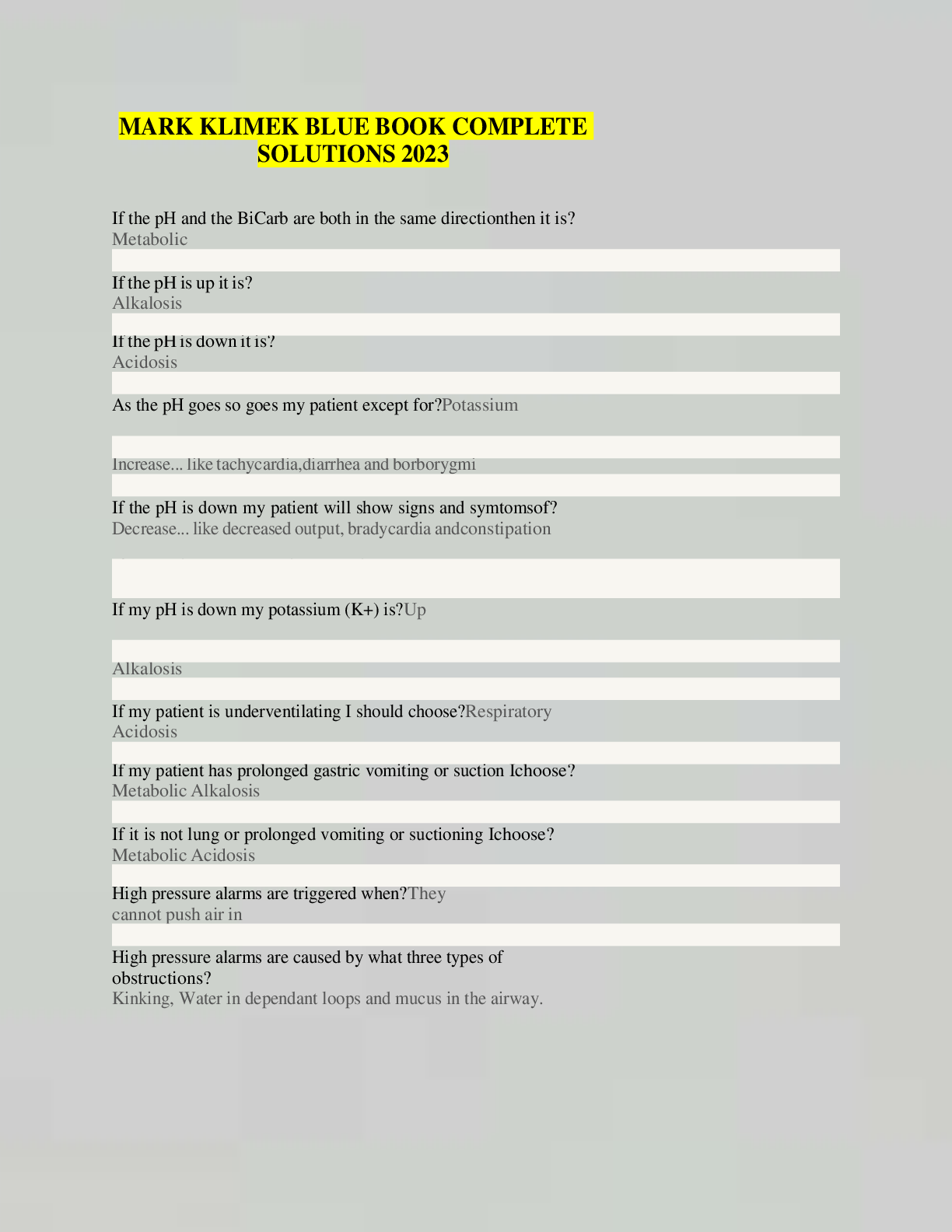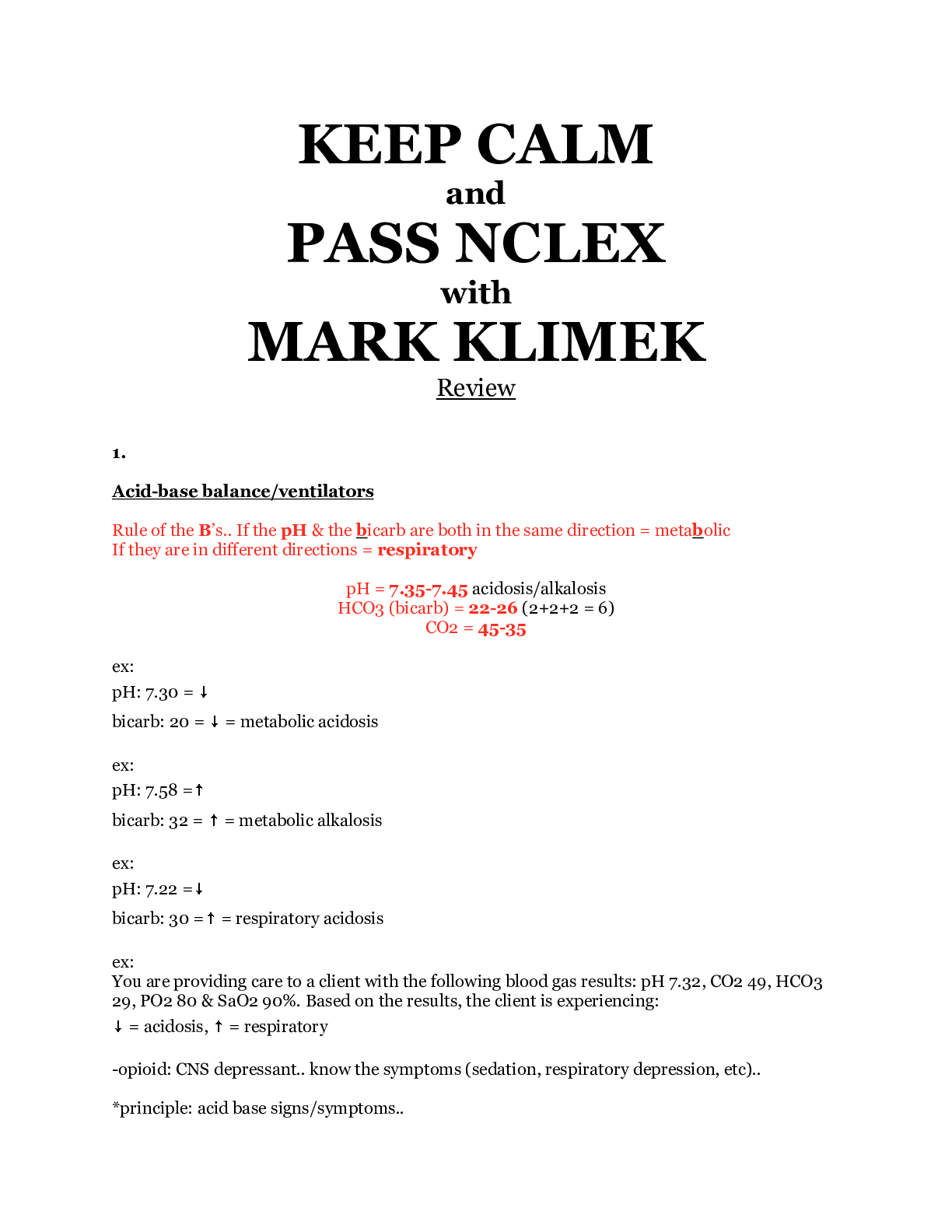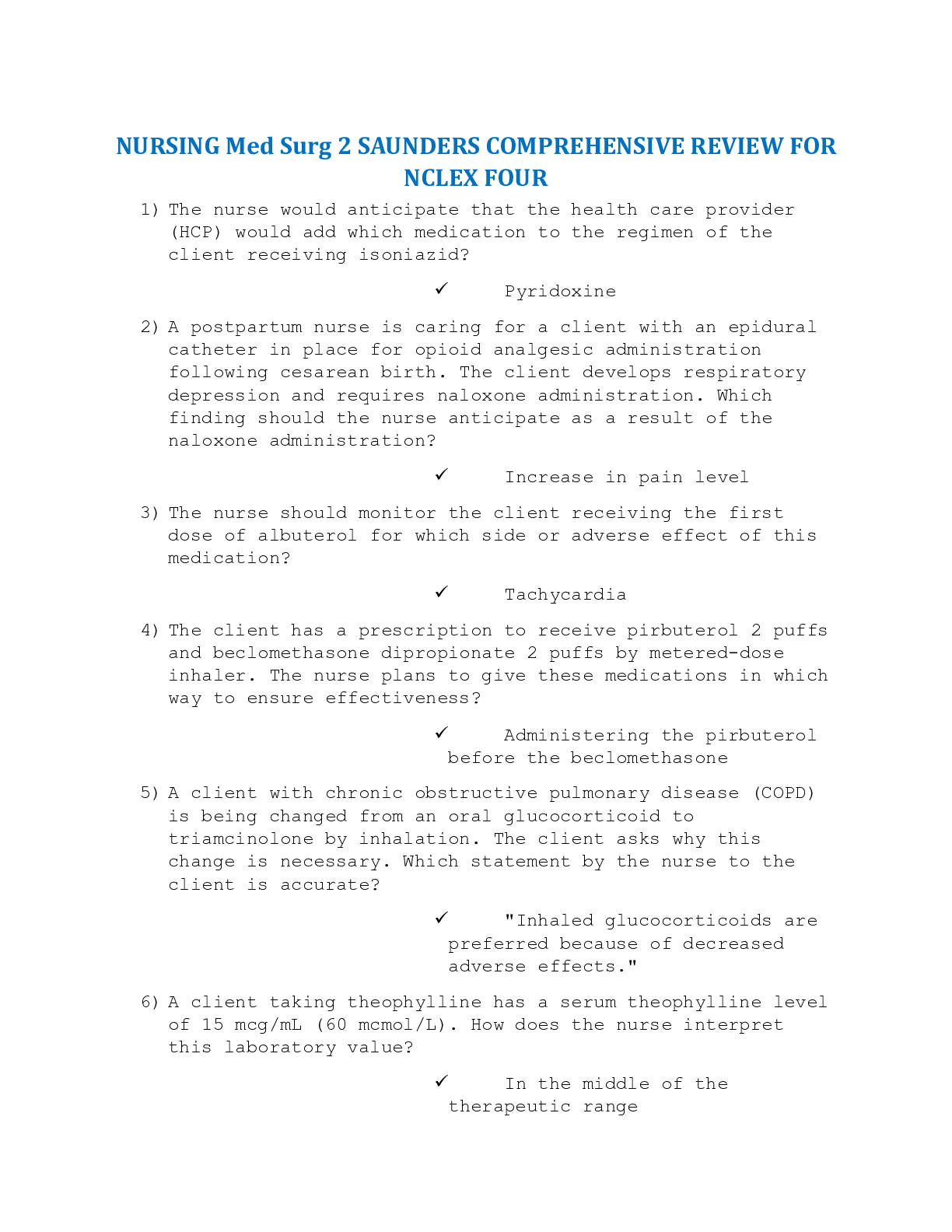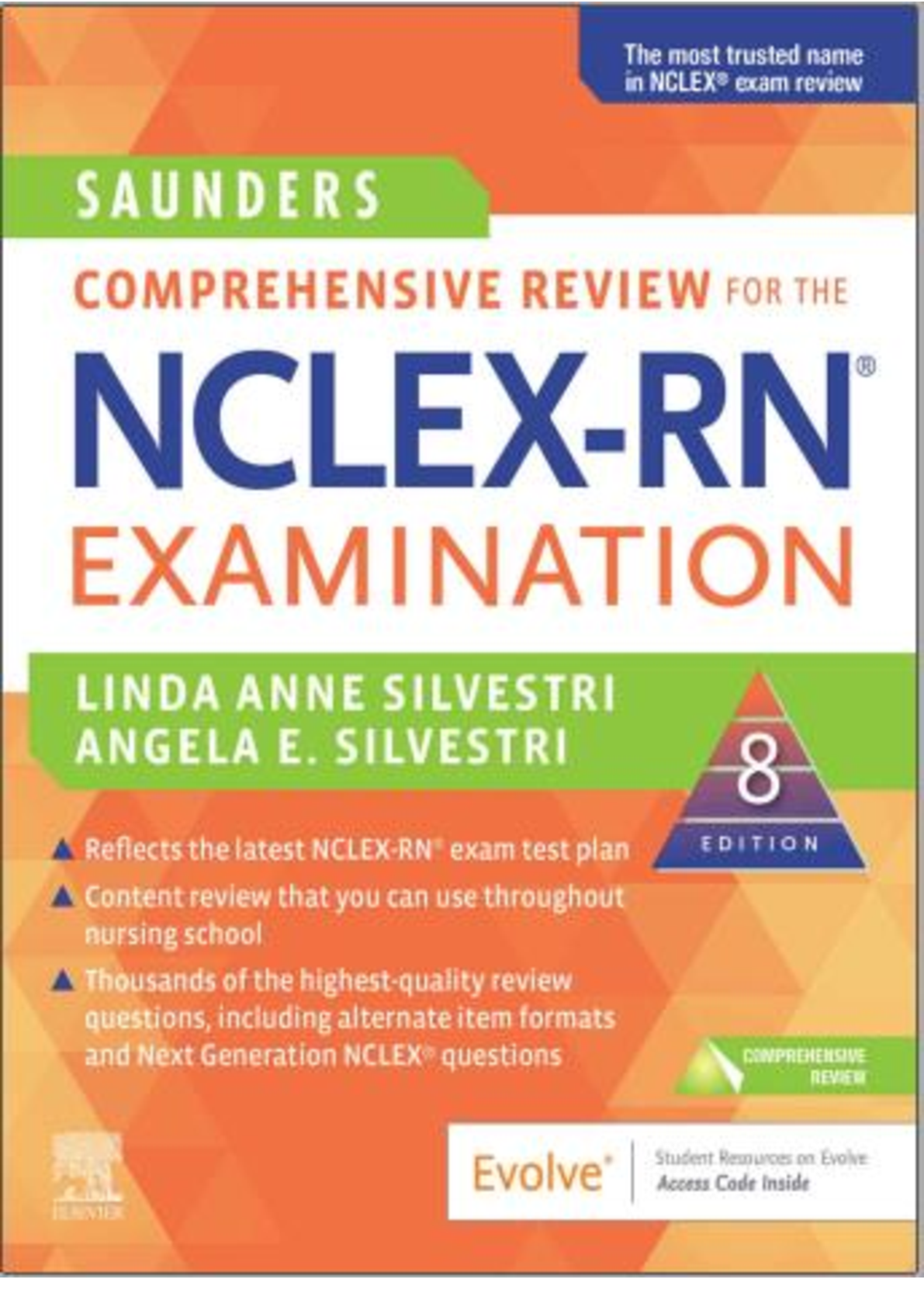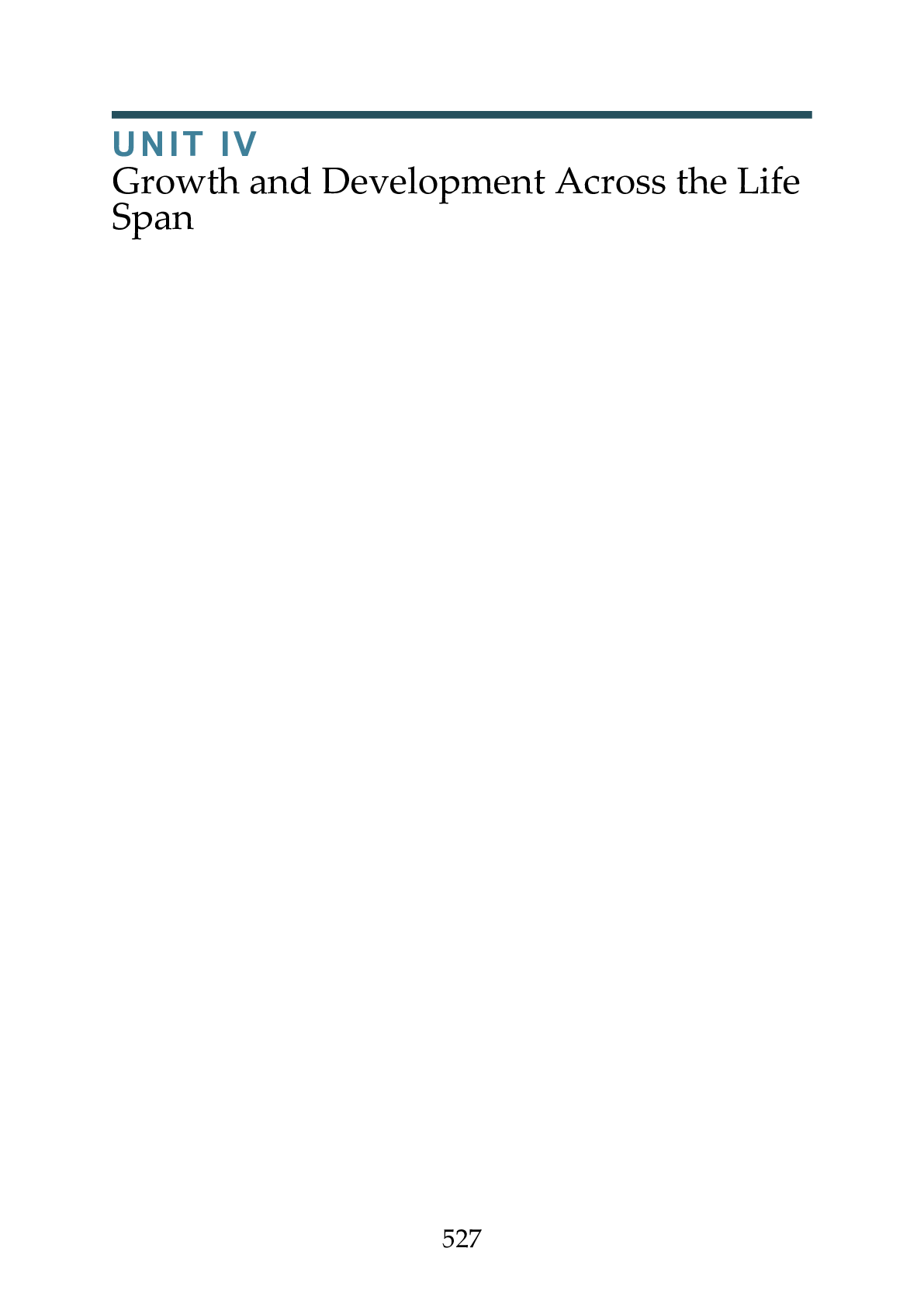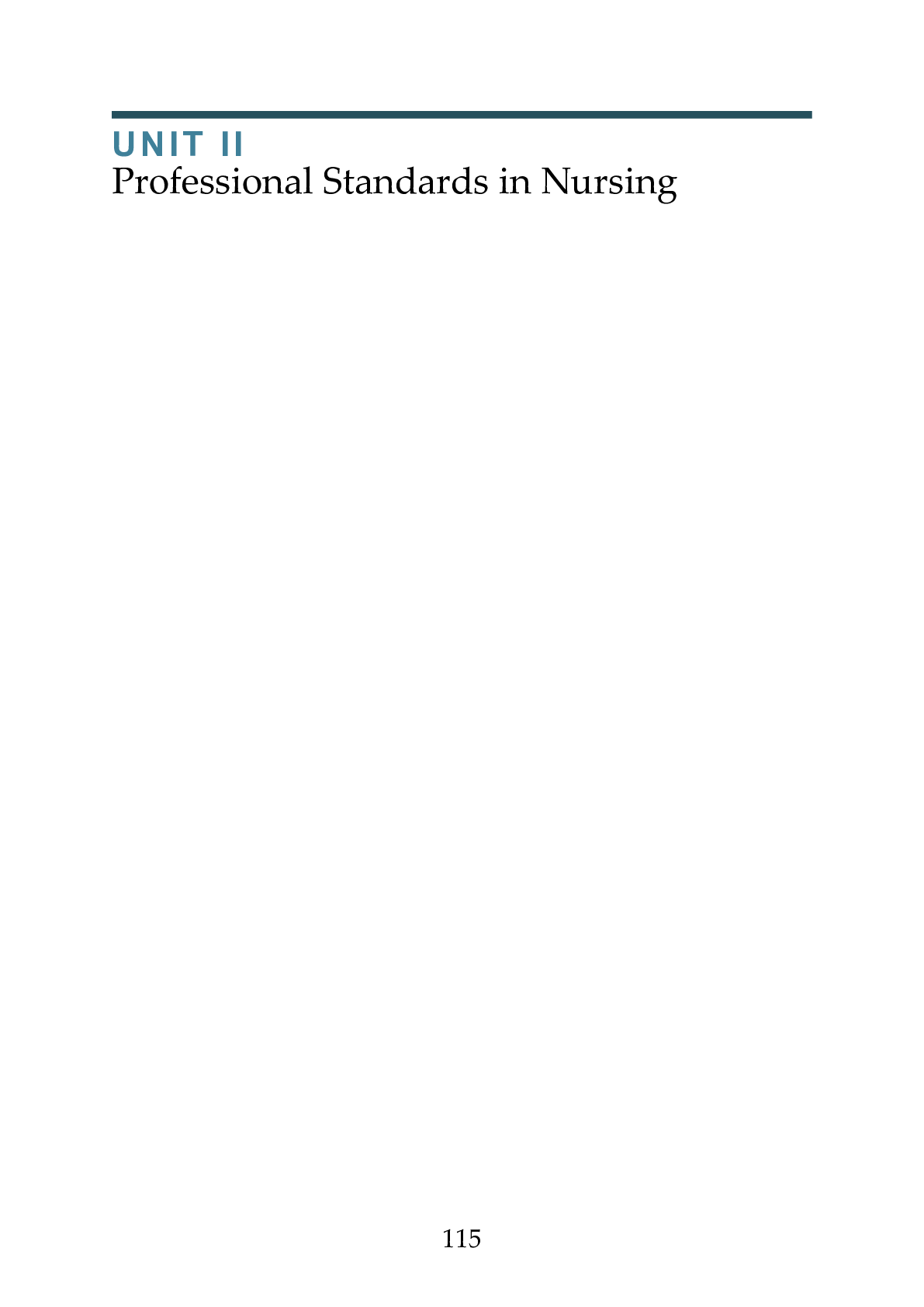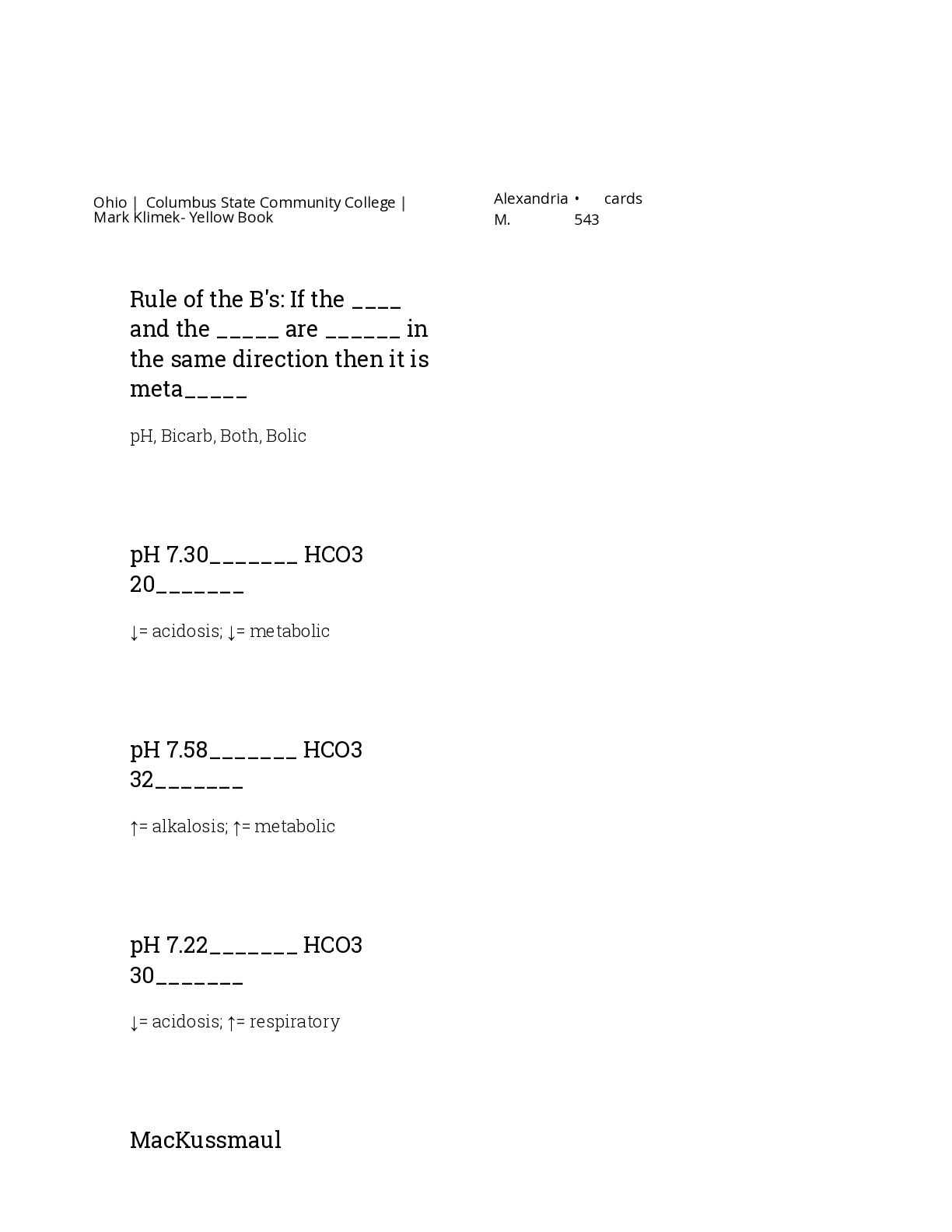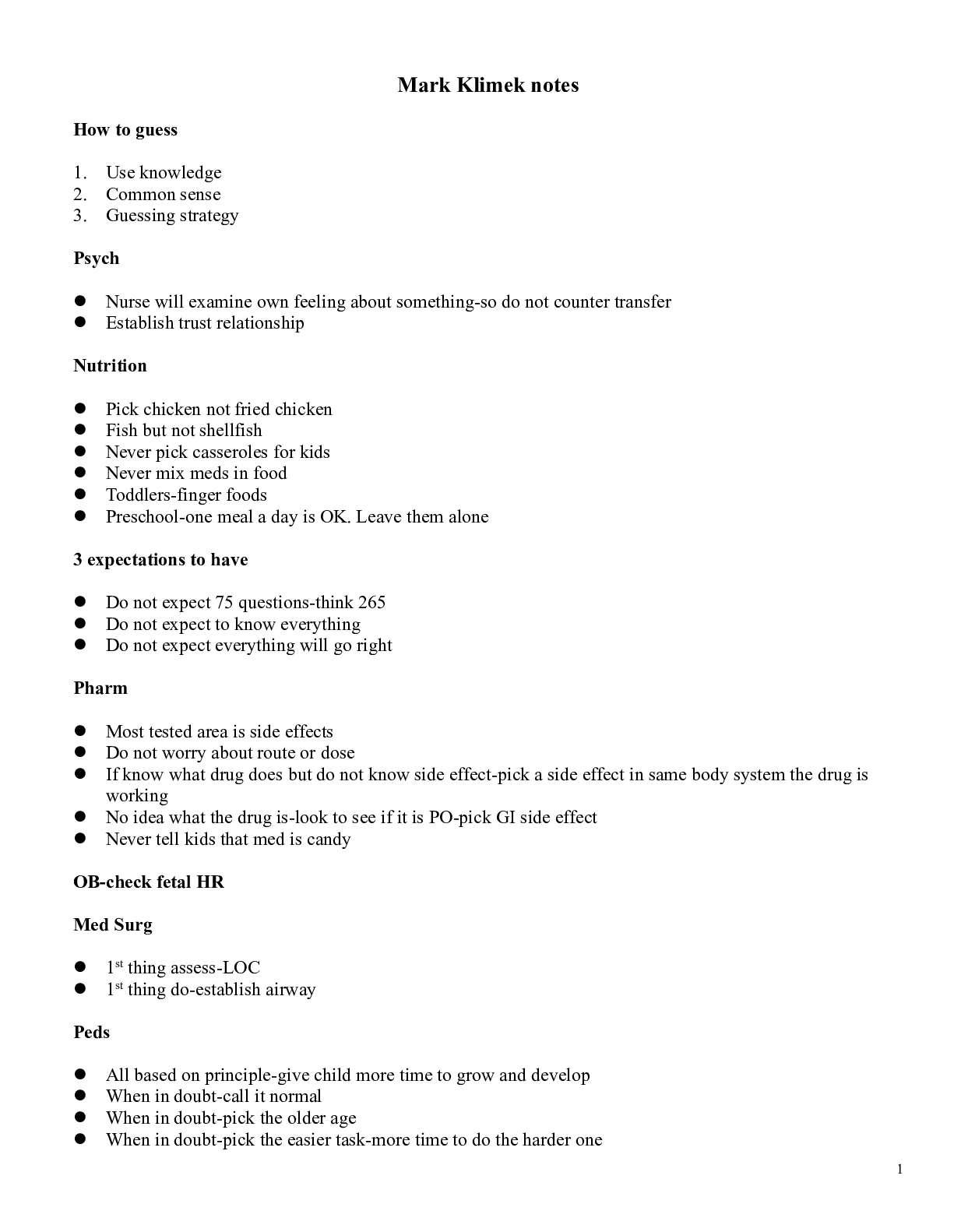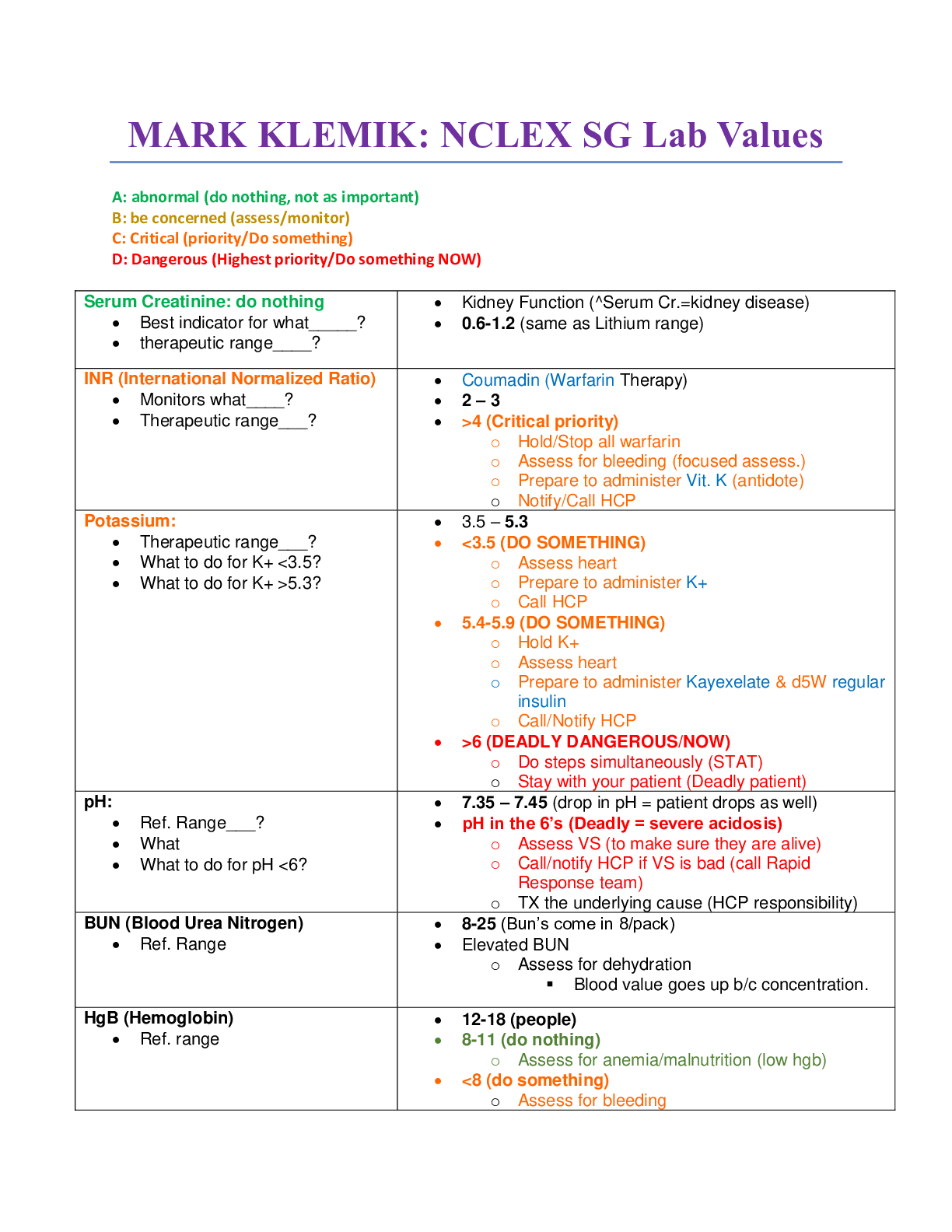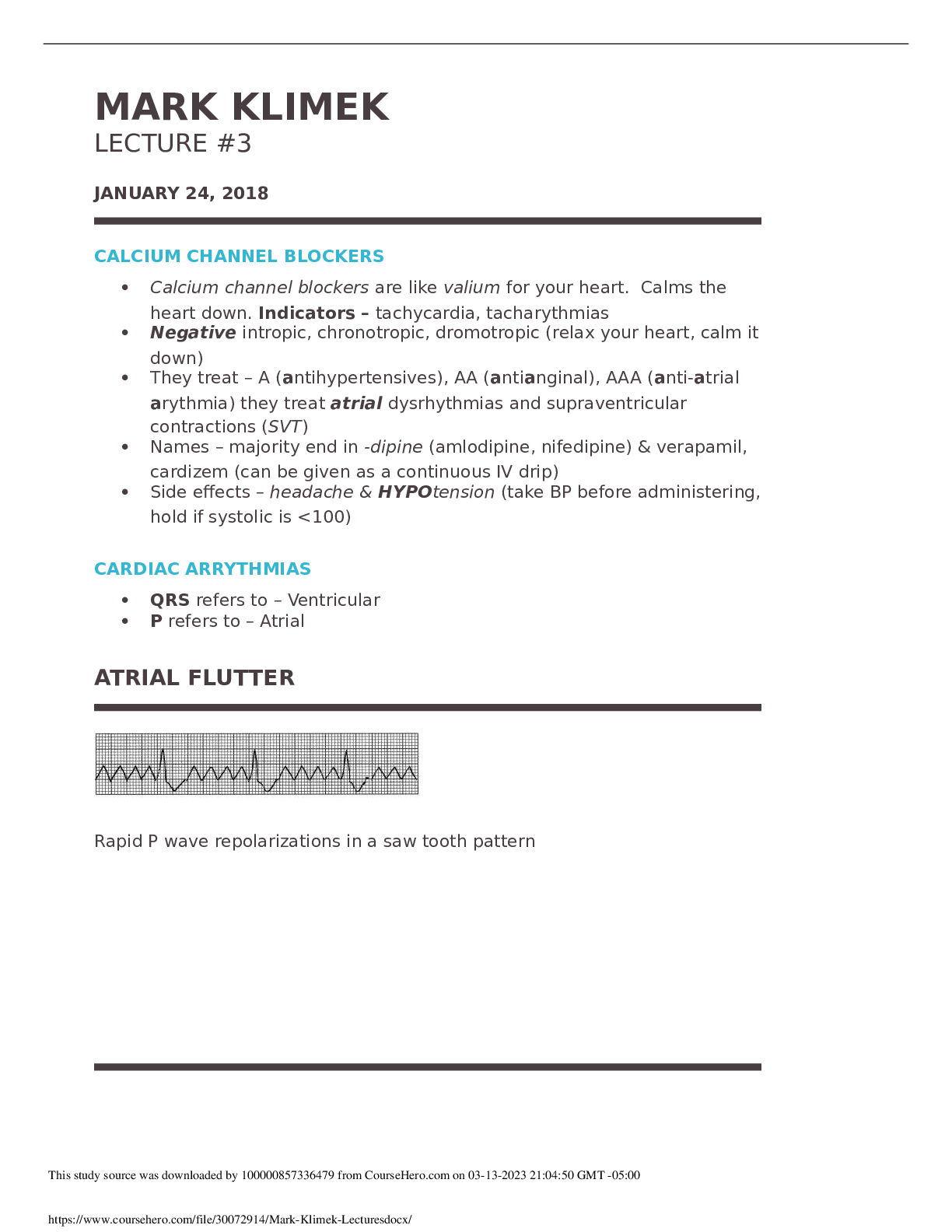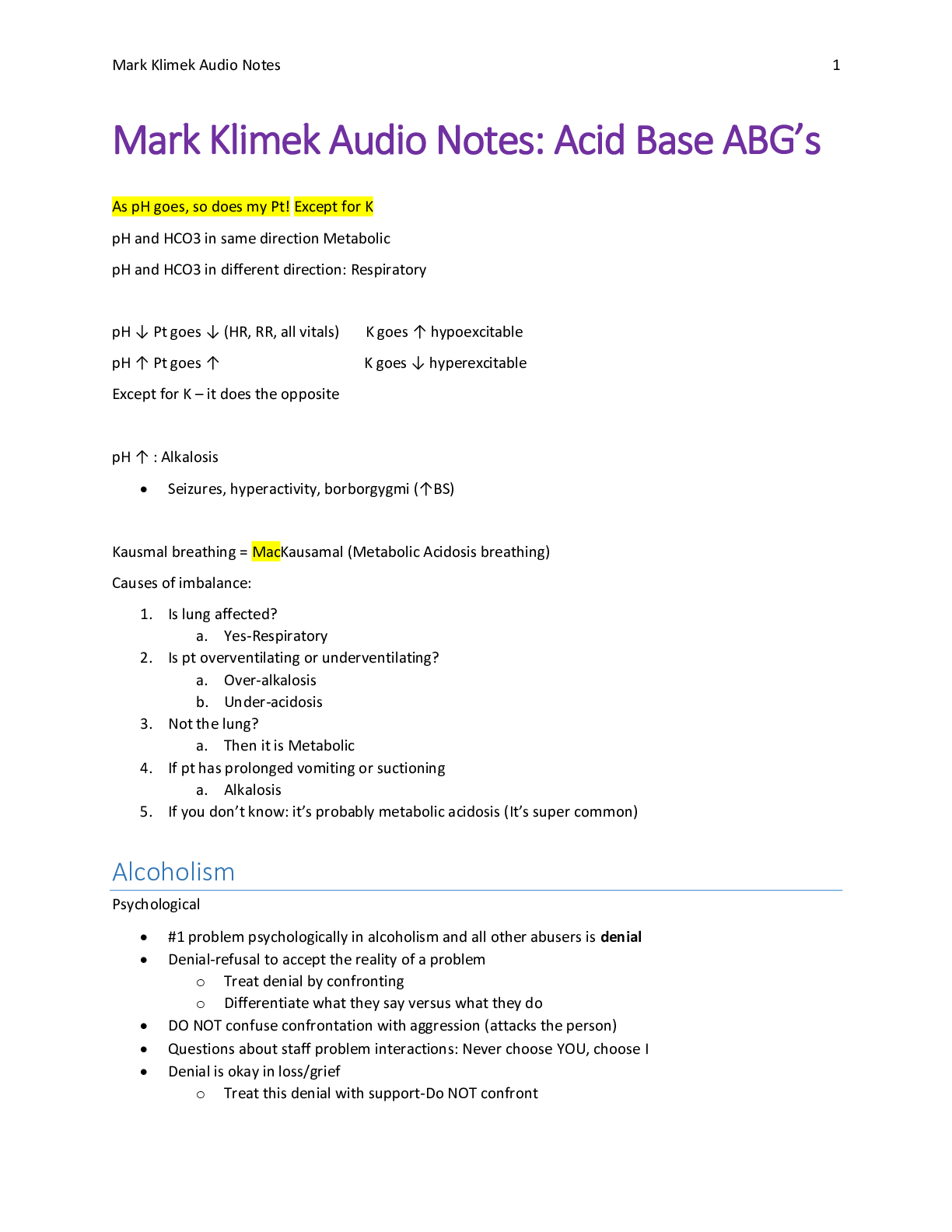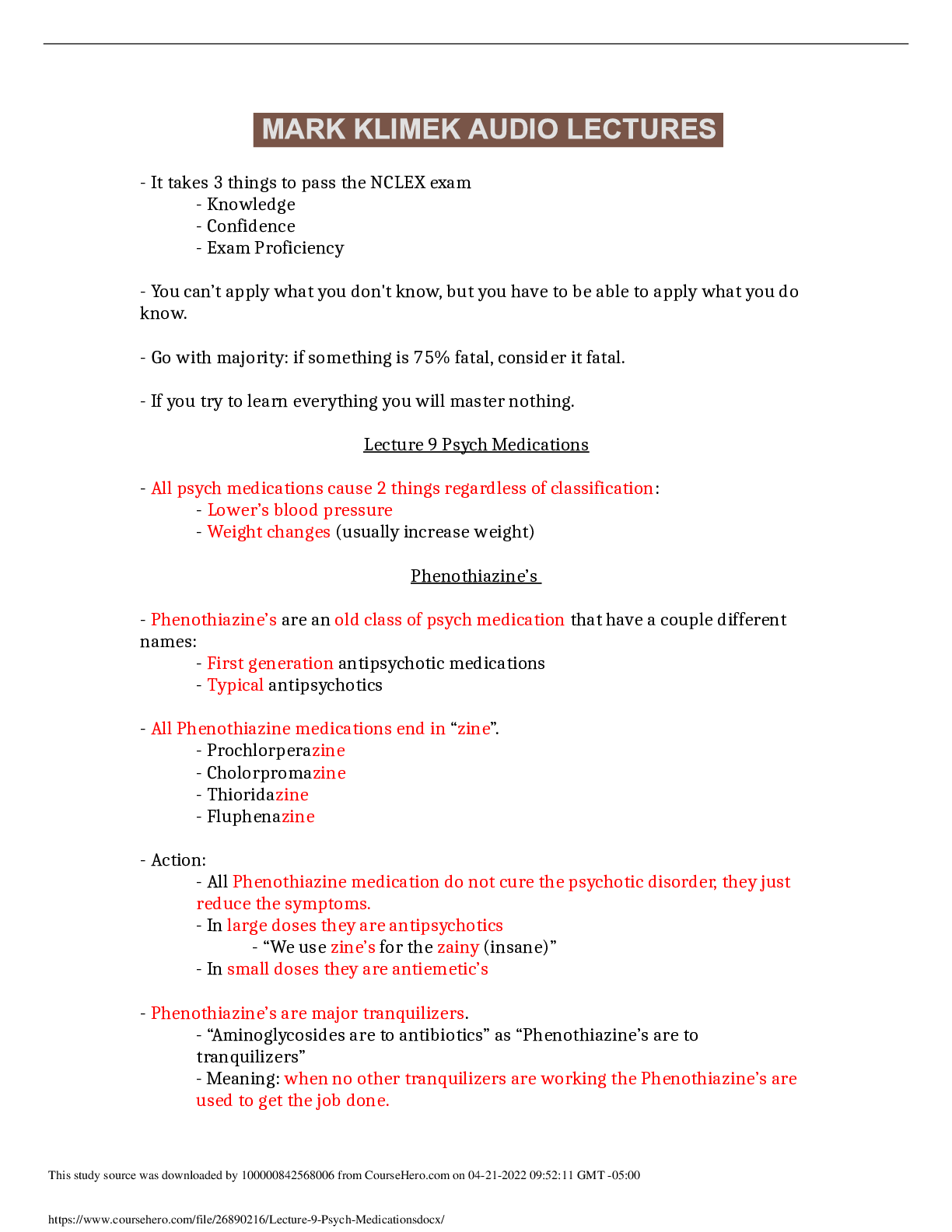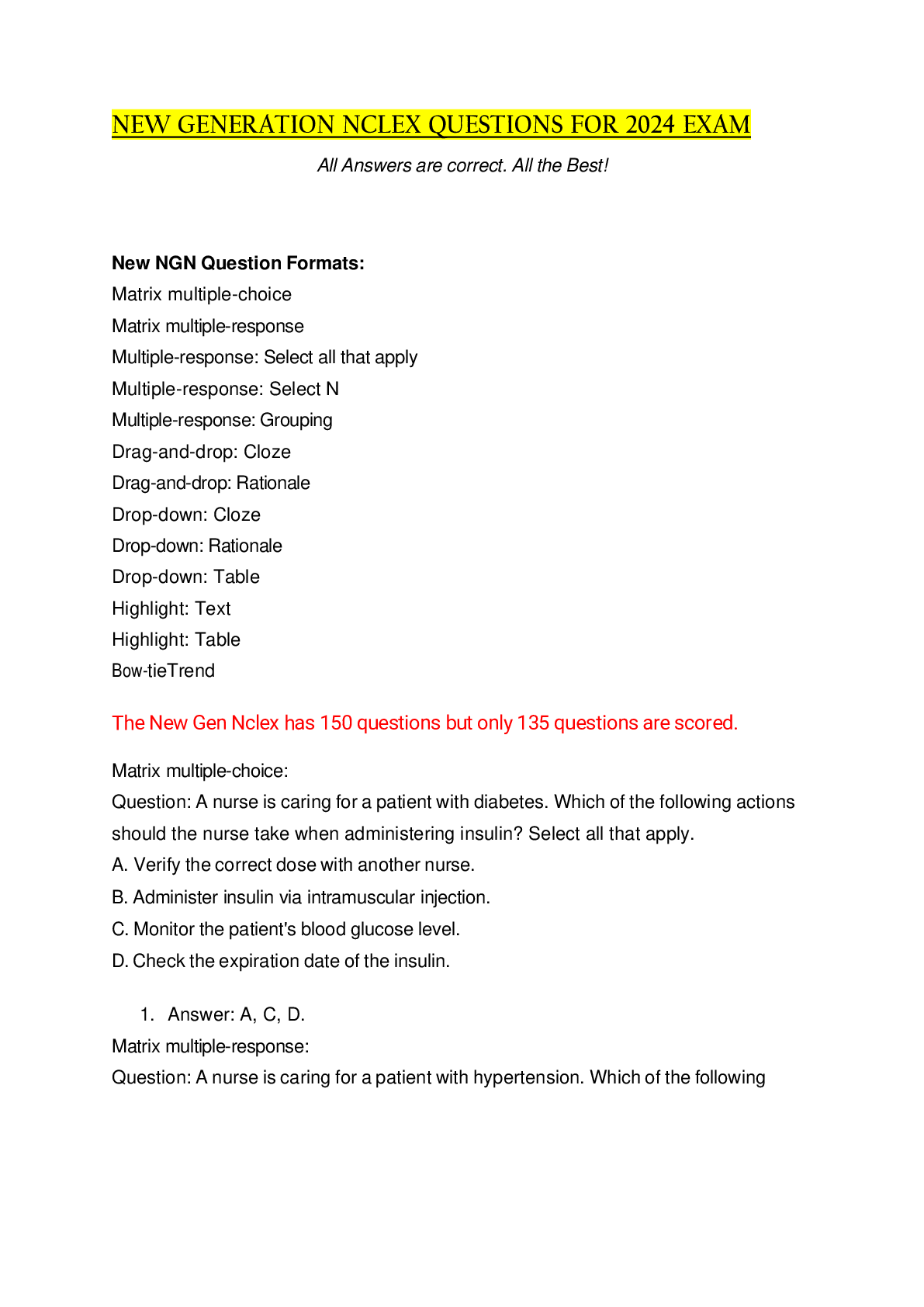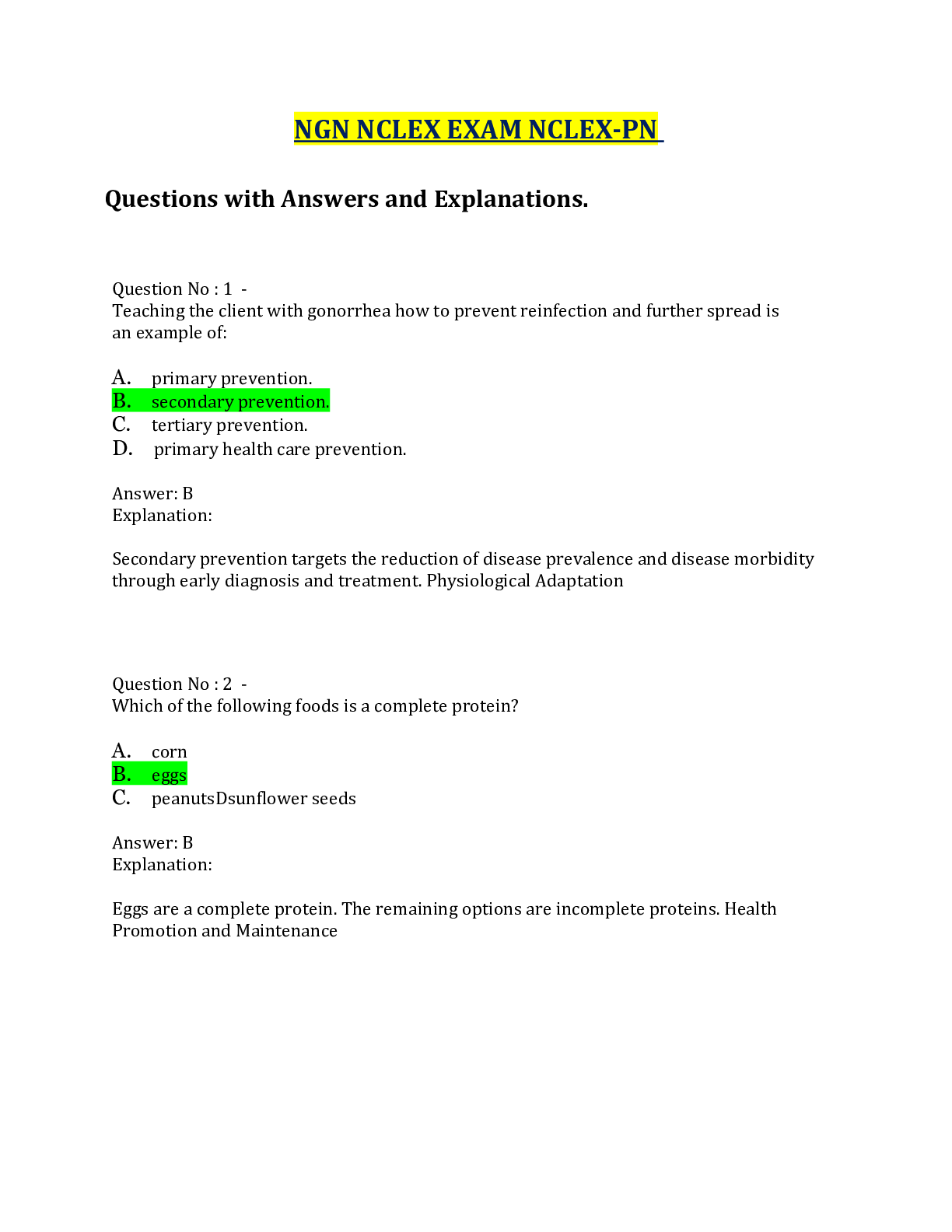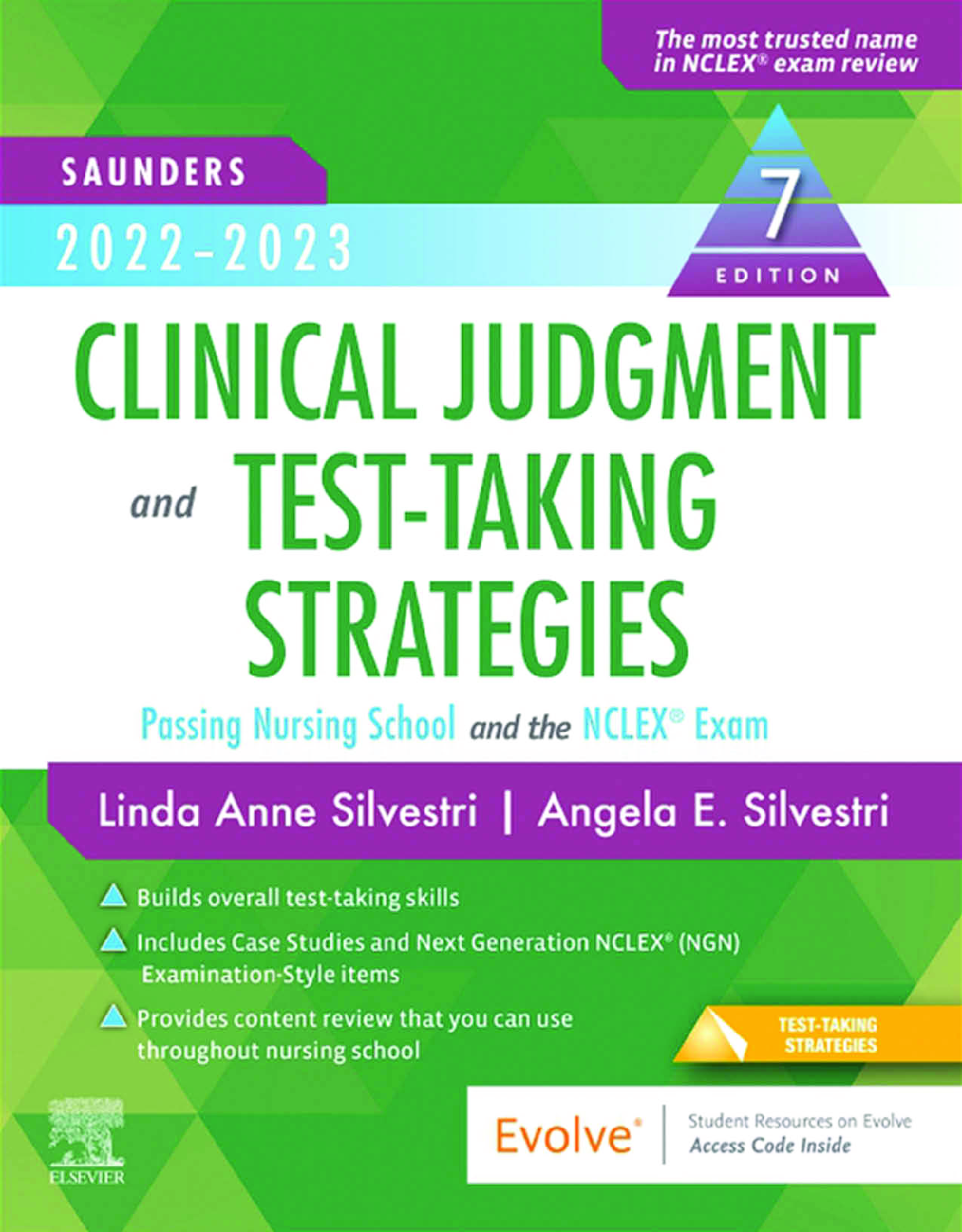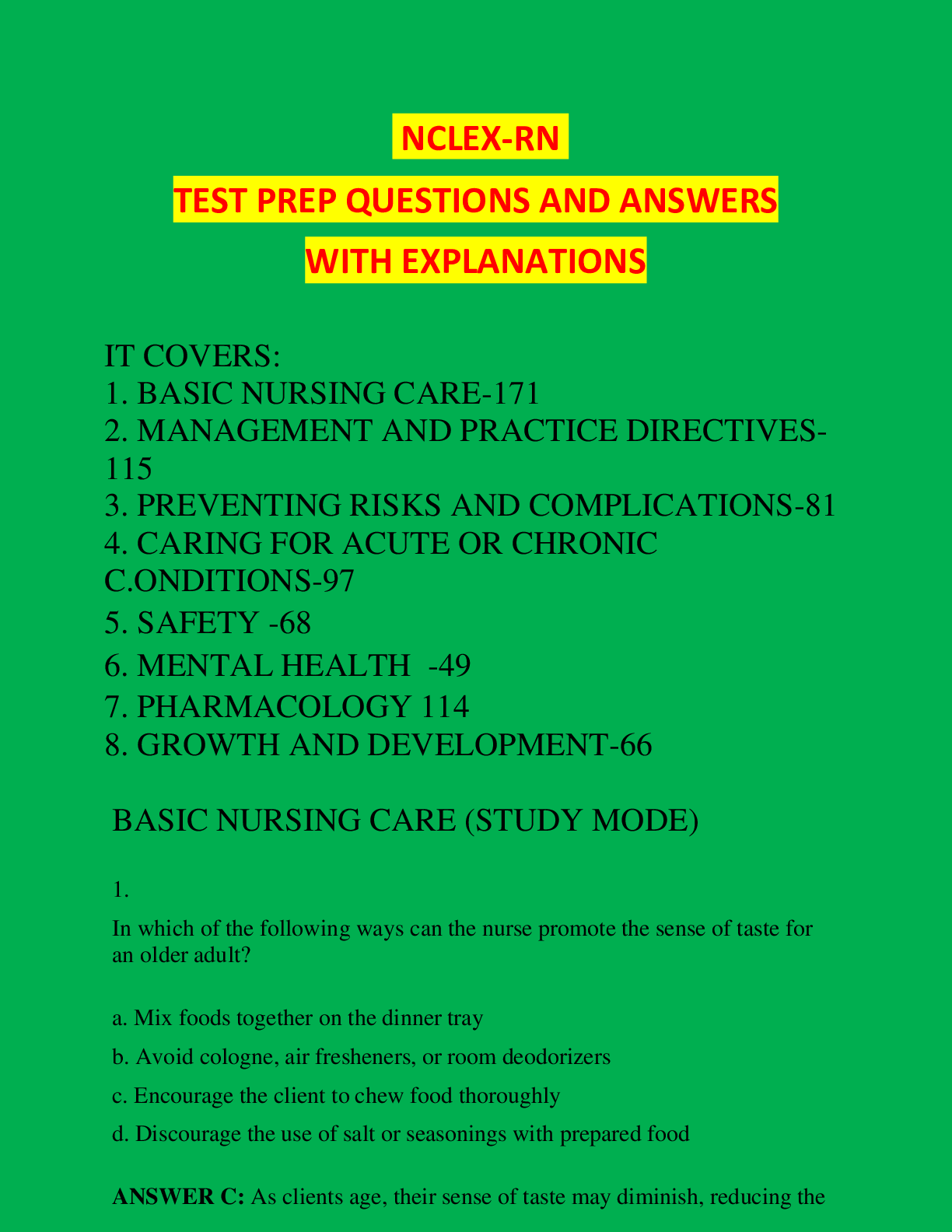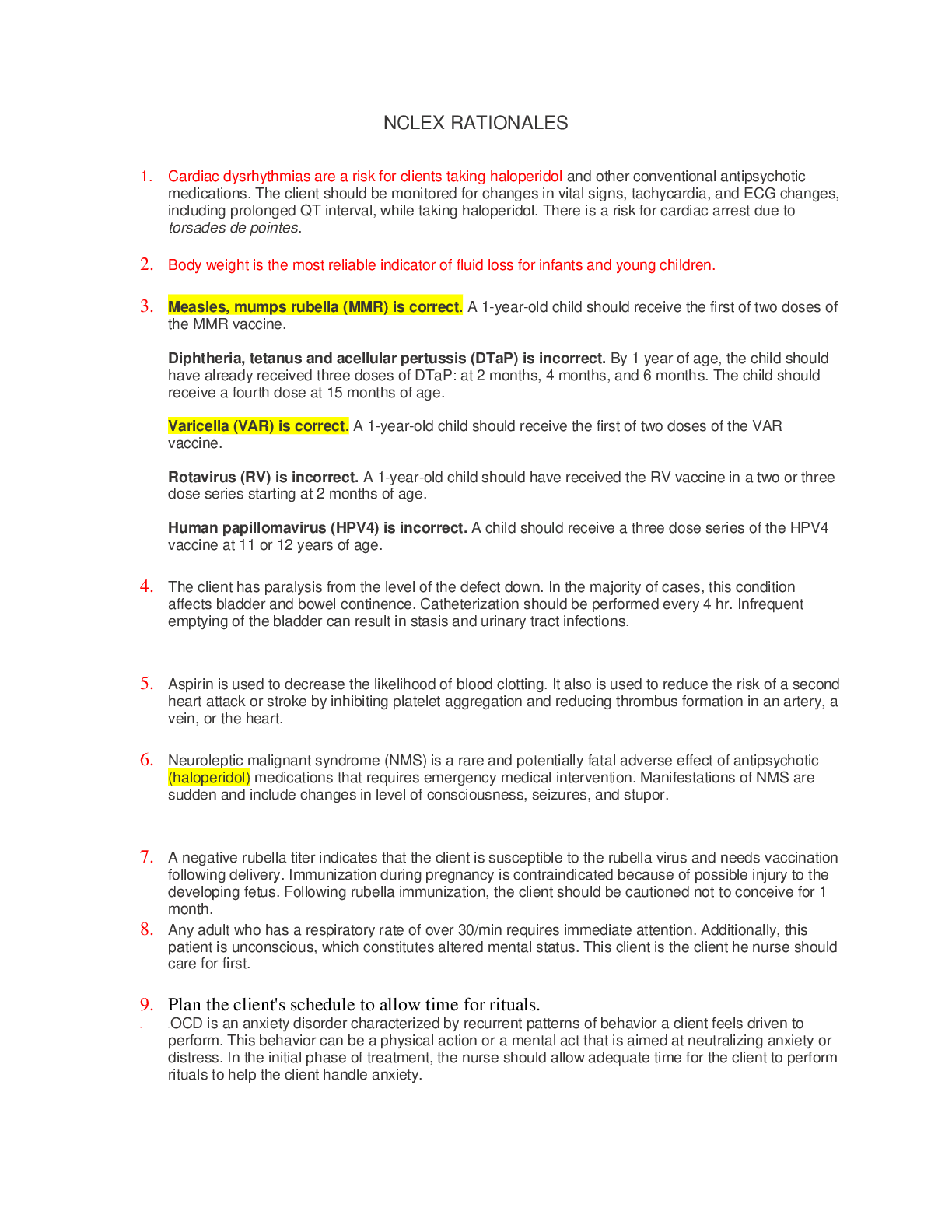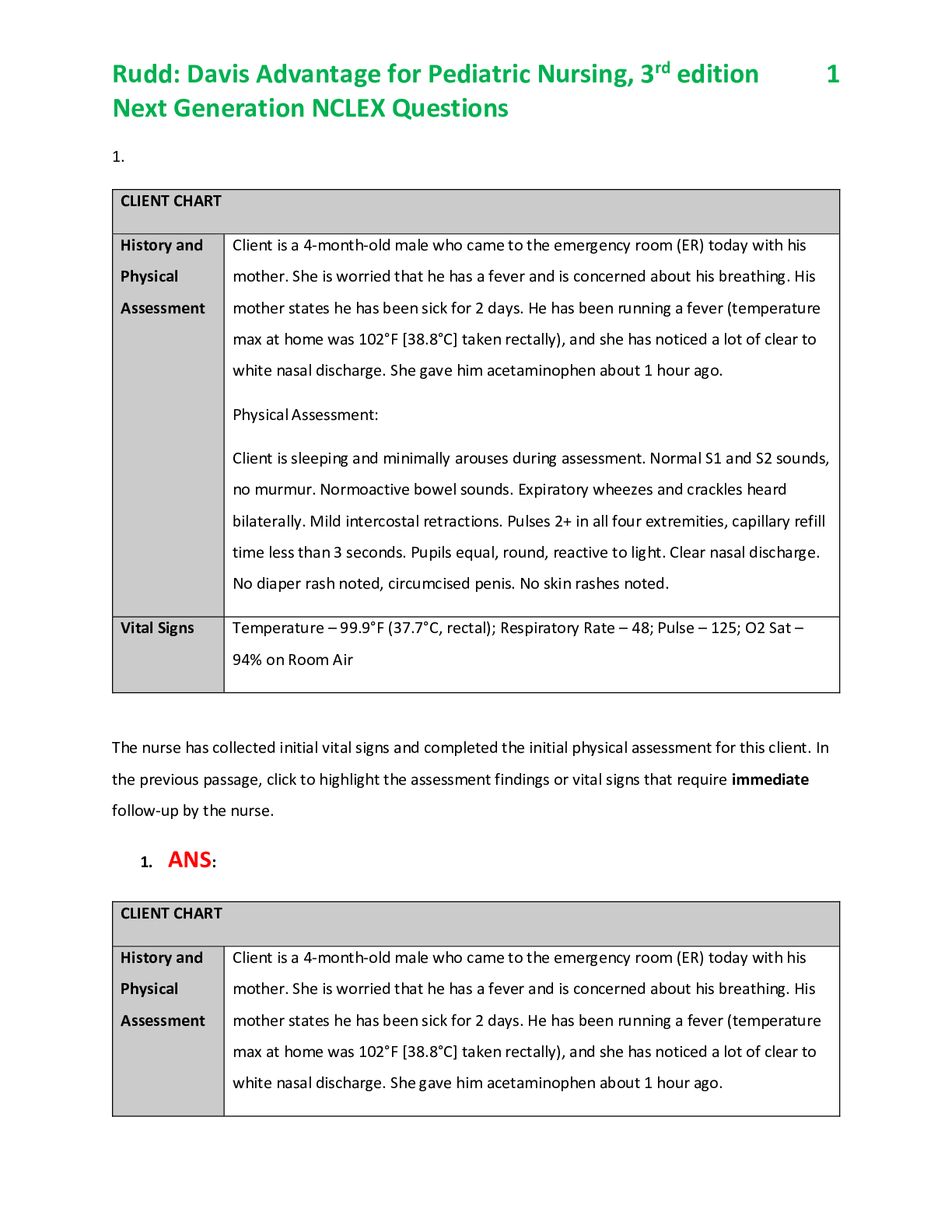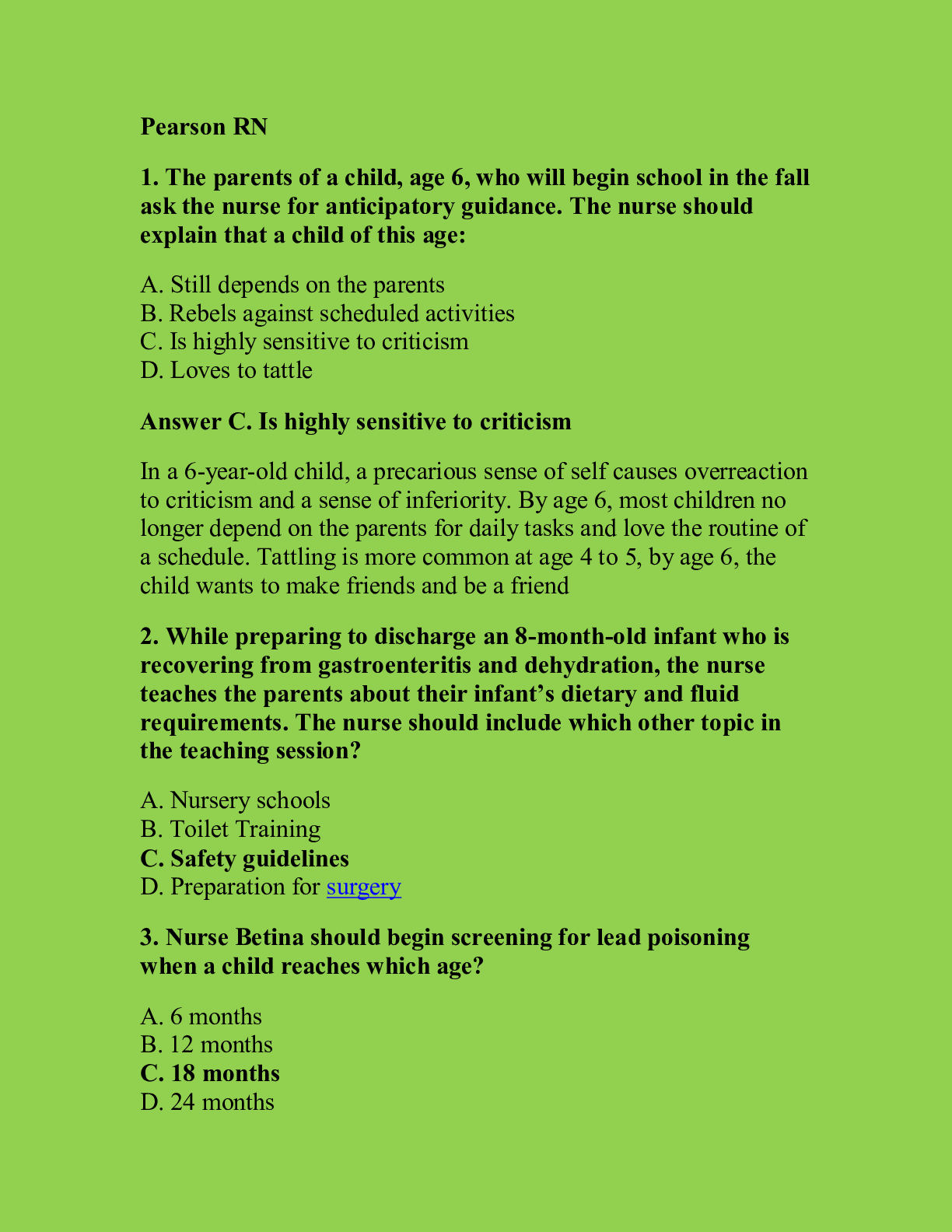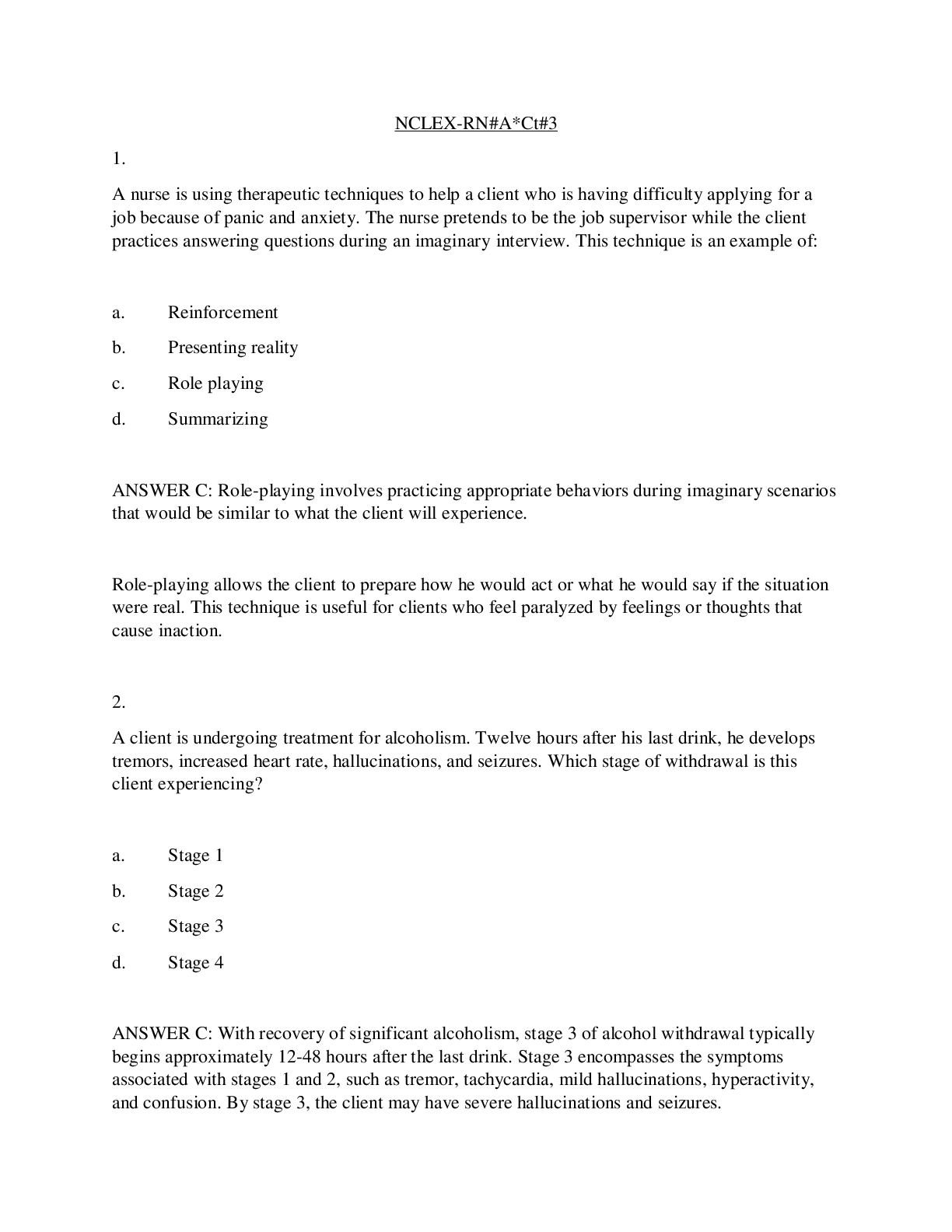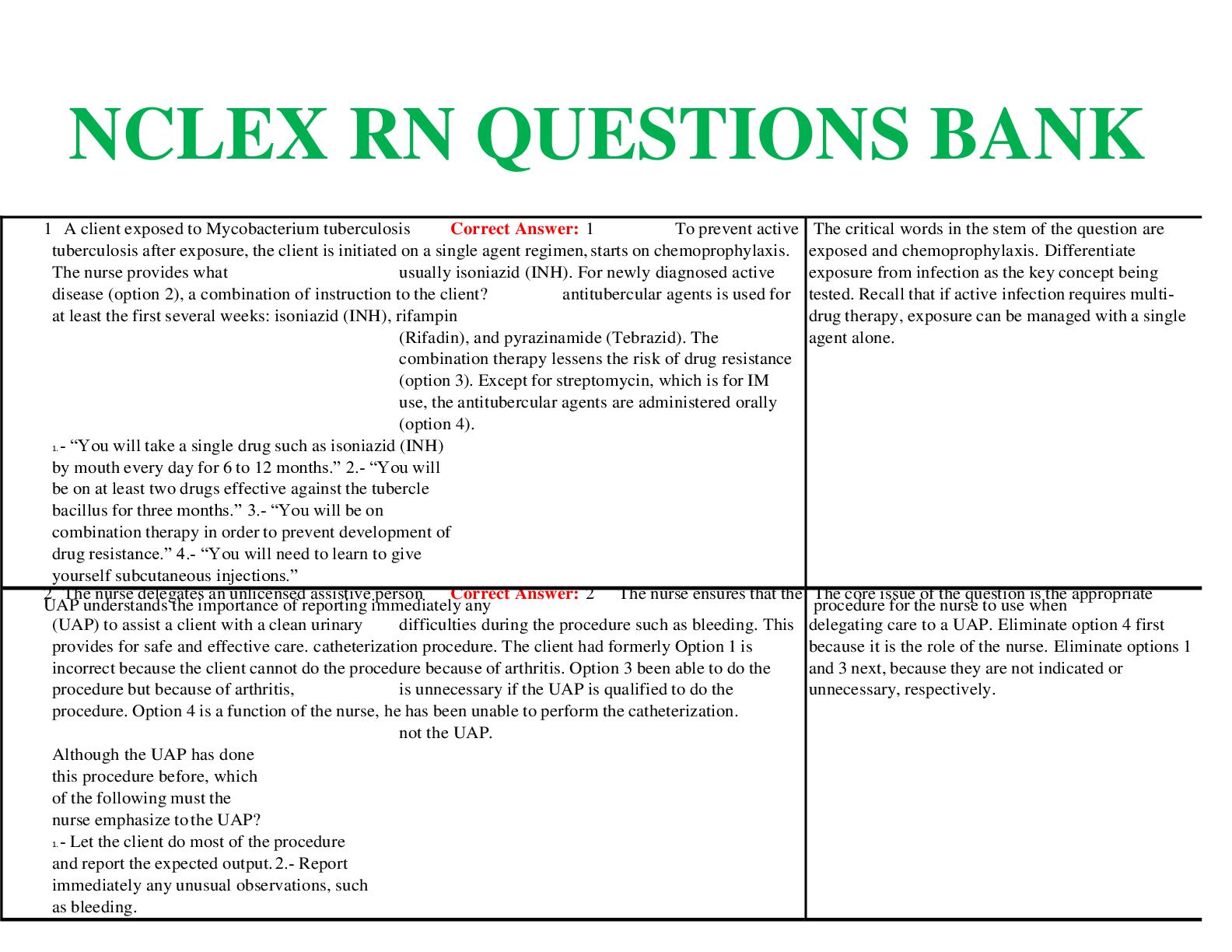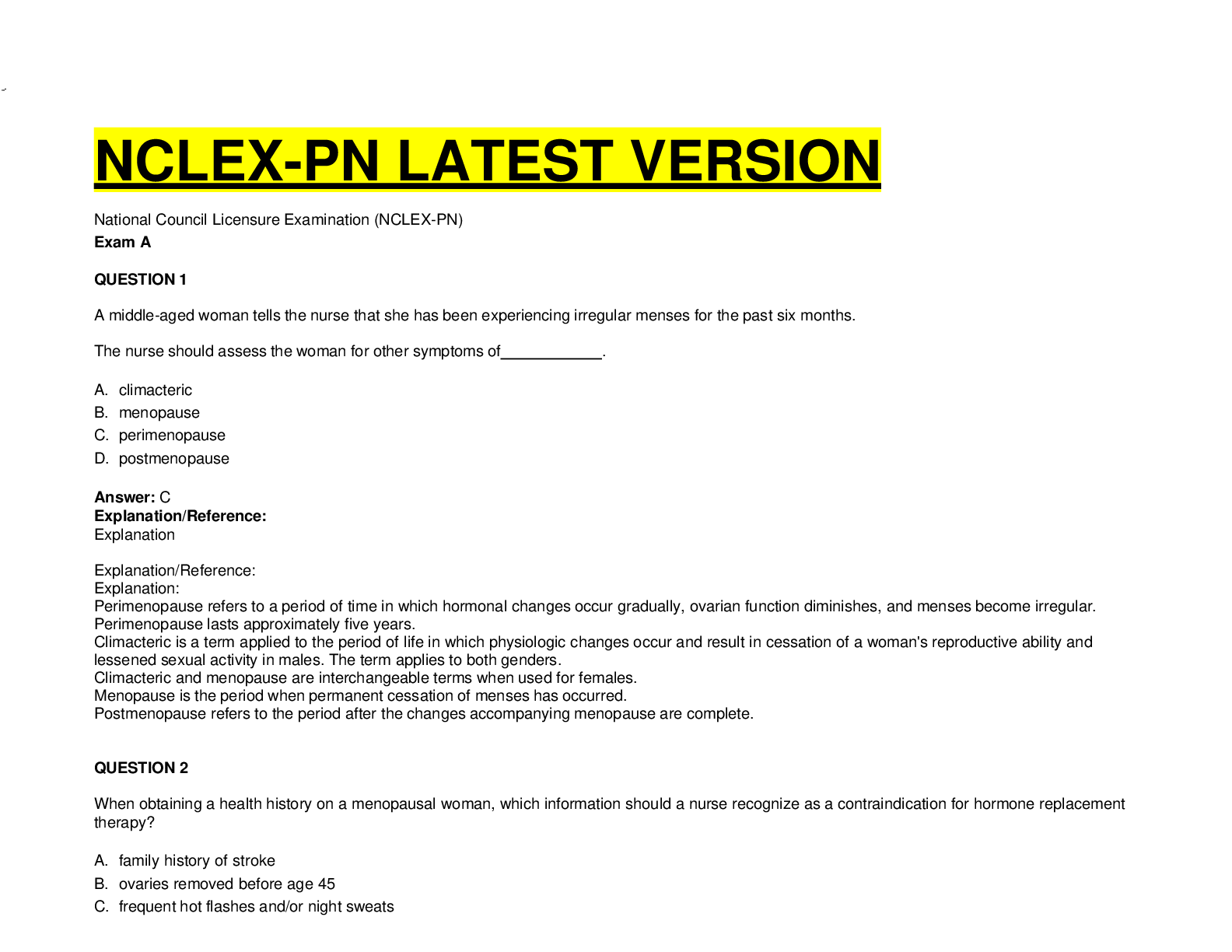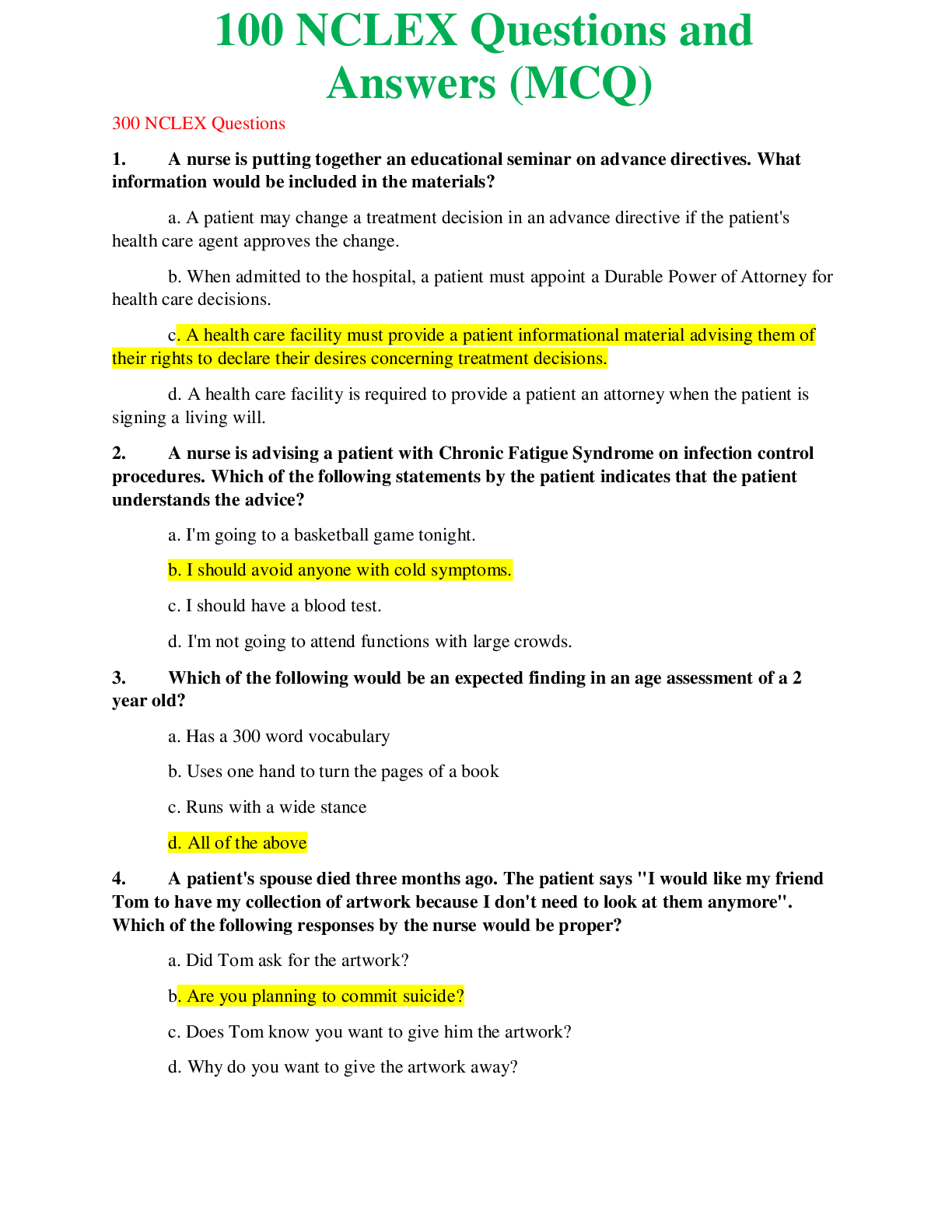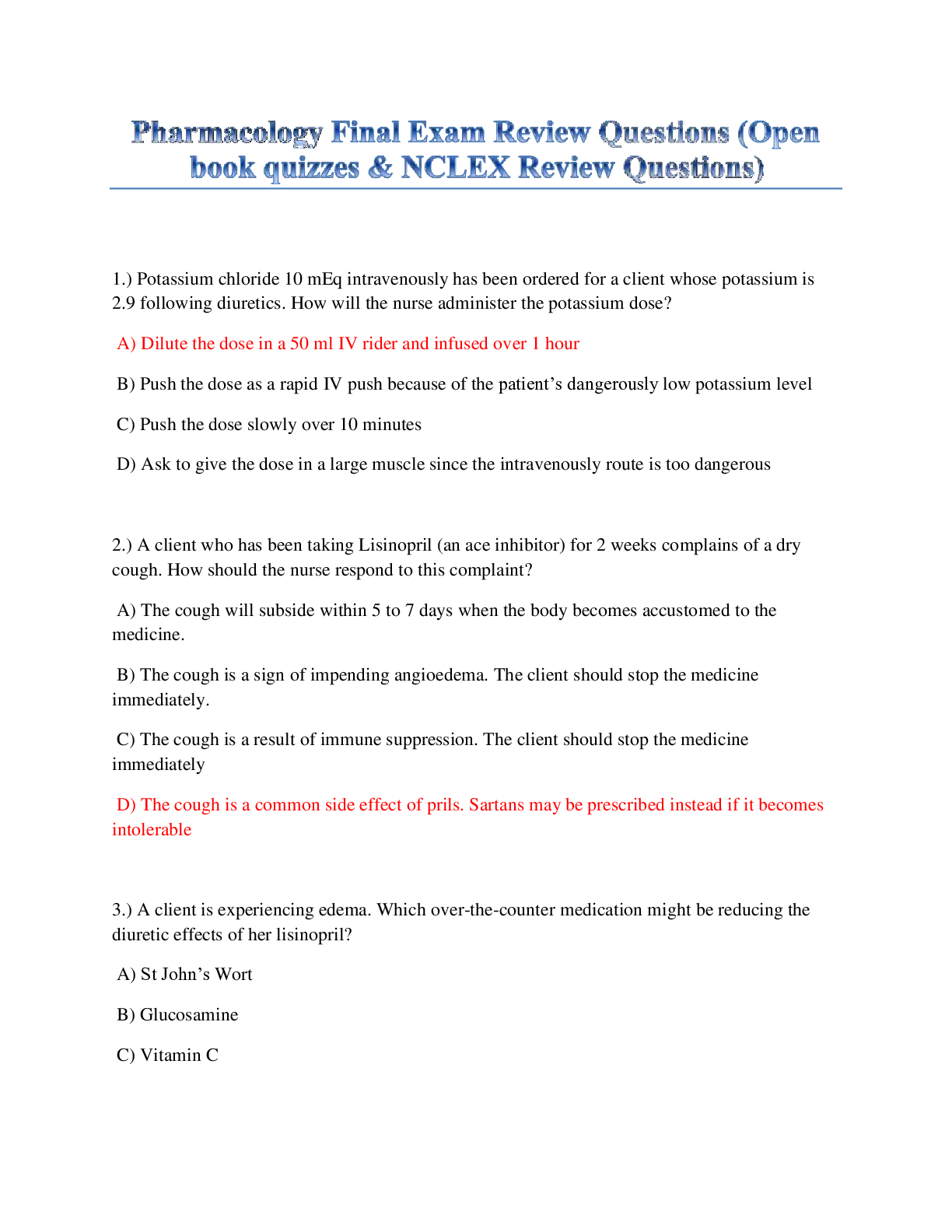*NURSING > NCLEX > HESI NCLEX Study Guide. A 35 PAGE, Comprehensive Compilation Containing the most Crucial Information (All)
HESI NCLEX Study Guide. A 35 PAGE, Comprehensive Compilation Containing the most Crucial Information For the Last Minute HESI NCLEX Exam Prep.
Document Content and Description Below
SAMPLE CONTENT: DO NOT delegate what you can EAT! E - evaluate A - assess T - teach addisons= down, down down up down cushings= up up up down up addisons= hyponatremia, hypotension, decreased bl... ood vol, hyperkalemia, hypoglycemia cushings= hypernatremia, hypertension, incrased blood vol, hypokalemia, hyperglycemia No Pee, no K (do not give potassium without adequate urine output) EleVate Veins; dAngle Arteries for better perfusion A= appearance (color all pink, pink and blue, blue [pale]) P= pulse (>100, < 100, absent) G= grimace (cough, grimace, no response) A= activity (flexed, flaccid, limp) R= respirations (strong cry, weak cry, absent) TRANSMISSION-BASED PRECAUTIONS: AIRBORNE My - Measles Chicken - Chicken Pox/Varicella Hez - Herpez Zoster/Shingles TB or remember... MTV=Airborne Measles TB Varicella-Chicken Pox/Herpes Zoster-Shingles Private Room - negative pressure with 6-12 air exchanges/hr Mask, N95 for TB DROPLET think of SPIDERMAN! S - sepsis S - scarlet fever S - streptococcal pharyngitis P - parvovirus B19 P - pneumonia P - pertussis I - influenza D - diptheria (pharyngeal) E - epiglottitis R - rubella M - mumps M - meningitis M - mycoplasma or meningeal pneumonia An - Adenovirus Private Room or cohort Mask 1CONTACT PRECAUTION MRS.WEE M - multidrug resistant organism R - respiratory infection S - skin infections * W - wound infxn E - enteric infxn - clostridium difficile E - eye infxn - conjunctivitis SKIN INFECTIONS VCHIPS V - varicella zoster C - cutaneous diphtheria H - herpez simplex I - impetigo P - pediculosis S - scabies 1. Air/Pulmonary Embolism (S&S: chest pain, difficulty breathing, tachycardia, pale/cyanotic, sense of impending doom) --> turn pt to left side and lower the head of the bed. 2. Woman in Labor w/ Un-reassuring FHR (late decels, decreased variability, fetal bradycardia, etc) --> turn on left side (and give O2, stop Pitocin, increase IV fluids) 3. Tube Feeding w/ Decreased LOC --> position pt on right side (promotes emptying of the stomach) with the HOB elevated (to prevent aspiration) 4. During Epidural Puncture --> side-lying 5. After Lumbar Puncture (and also oil-based Myelogram)--> pt lies in flat supine (to prevent headache and leaking of CSF) 6. Pt w/ Heat Stroke --> lie flat w/ legs elevated 7. During Continuous Bladder Irrigation (CBI) --> catheter is taped to thigh so leg should be kept straight. No other positioning restrictions. 8. After Myringotomy --> position on side of affected ear after surgery (allows drainage of secretions) 9. After Cataract Surgery --> pt will sleep on unaffected side with a night shield for 1-4 weeks. 10. After Thyroidectomy --> low or semi-Fowler's, support head, neck and shoulders. 11. Infant w/ Spina Bifida --> position prone (on abdomen) so that sac does not rupture 12. Buck's Traction (skin traction) --> elevate foot of bed for counter-traction 13. After Total Hip Replacement --> don't sleep on operated side, don't flex hip more than 45- 60 degrees, don't elevate HOB more than 45 degrees. Maintain hip abduction by separating thighs with pillows. 14. Prolapsed Cord --> knee-chest position or Trendelenburg 215. Infant w/ Cleft Lip --> position on back or in infant seat to prevent trauma to suture line. While feeding, hold in upright position. 16. To Prevent Dumping Syndrome (post-operative ulcer/stomach surgeries) --> eat in reclining position, lie down after meals for 20-30 minutes (also restrict fluids during meals, low CHO and fiber diet, small frequent meals) 17. Above Knee Amputation --> elevate for first 24 hours on pillow, position prone daily to provide for hip extension. 18. Below Knee Amputation --> foot of bed elevated for first 24 hours, position prone daily to provide for hip extension. 19. Detached Retina --> area of detachment should be in the dependent position 20. Administration of Enema --> position pt in left side-lying (Sim's) with knee flexed 21. After Supratentorial Surgery (incision behind hairline) --> elevate HOB 30-45 degrees 22. After Infratentorial Surgery (incision at nape of neck)--> position pt flat and lateral on either side. 23. During Internal Radiation --> on bedrest while implant in place 24. Autonomic Dysreflexia/Hyperreflexia (S&S: pounding headache, profuse sweating, nasal congestion, goose flesh, bradycardia, hypertension) --> place client in sitting position (elevate HOB) first before any other implementation. 25. Shock --> bedrest with extremities elevated 20 degrees, knees straight, head slightly elevated (modified Trendelenburg) 26. Head Injury --> elevate HOB 30 degrees to decrease intracranial pressure 27. Peritoneal Dialysis when Outflow is Inadequate --> turn pt from side to side BEFORE checking for kinks in tubing (according to Kaplan) 28. Lumbar puncture => AFTER the procedure, the client should be placed in the supine position for 4 to 12 hrs as prescribed. (Saunders 3rd ed p. 229) Demorol for pancreatitis, NOT morphine sulfate Myasthenia Gravis: worsens with exercise and improves with rest. Myasthenia Crisis: a positive reaction to Tensilon--will improve symptoms Cholinergic Crisis: caused by excessive medication-stop med-giving Tensilon will make it worse Head injury medication: Mannitol (osmotic diuretic)-crystallizes at room temp so ALWAYS use filter needle Prior to a liver biospy its important to be aware of the lab result for prothrombin time From the a** (diarrhea)= metabolic acidosis From the mouth (vomitus)=metabolic alkalosis Myxedema/hypothyroidism: slowed physical and mental function, sensitivity to cold, dry skin and hair 3Graves’ disease/hyperthyroidism: accelerated physical and mental function; sensitivity to heat, fine/soft hair Thyroid storm: increased temp, pulse and HTN Post-thyroidectomy: semi-Fowler’s, prevent ncek flexion/hyperextension, trach at bedside Hypo-parathyroid: CATS – convulsions, arrhythmias, tetany, spasms, stridor (decreased calcium), high Ca, low phosphorus diet Hyper-parathyroid: fatigue, muscle weakness, renal calculi, back and joint pain (increased calcium), low Ca, high phosphorus diet Hypovolemia – incrased temp, rapid/weak pulse, increase respiration, hypotension, anxiety, urine specific gravity >1.030 Hypervolemia – bounding pulse, SOB, dyspnea, rares/crackles, peripheral edema, HTN, urine specific gravity <1.010; Semi-Fowler’s Diabetes Insipidus (decreased ADH): excessive urine output and thirst, dehydration, weakness, administer Pitressin SIADH (increased ADH): change in LOC, decreased deep tendon reflexes, tachycardia, n/v/a, HA; administer Declomycin, diuretics Hypokalemia: muscle ewakness, dysrhythmias, increase K (raisins, bananas, apricots, oranges, beans, potatoes, carrots, celery) Hyperkalemia: MURDER – muscle weakness, urine (oliguria/anuria), respiratory depression, decreased cardiac contractility, ECG changes, reflexes Hyponatremia: nausea, muscle cramps, increased ICP, muscular twitching, convulsion; osmotic diuretics, fluids Hypernatremia: increased temp, weakness, disorientation/delusions, hypotension, tachycardia; hypotonic solution Hypocalcemia: CATS – convulsions, arrhythmias, tetany, spasms and stridor Hypercalcemia: muscle weakness, lack of coordination, abdominal pain, confusion, absent tendon reflexes, sedative effect on CNS HypoMg: tremors, tetany, seizures, dyrshythmias, depression, confusion, dysphagia; dig toxicity HyperMg: depresses the CNS, hypotension, facial flushing, muscle ewakness, absent deep tendon reflexes, shallow respirations, emergency Addison’s: hypoNa, hyperK, hypoglycemia, dark pigmentation, decreased resistance to stress, fractures, alopecia, weight loss, GI distress Cushings: hyperNa, hypoK, hyperglycemia, prone to infection, muscle wasting, weakness, edema, HTN, hirsutism, moonface/buffalo hump Addisonian crisis: n/v, confusion, abdominal pain, extreme weakness, hypoglycemia, dehydration, decreased BP Pheochromocytoma: hypersecretion of epi/norepi, persistent HTN, increased HR, hyperglycemia, diaphoresis, tremor, pounding HA; avoid stress, frequent bating and rest breaks, avoid cold and stimulating foods, surgery to remove tumor 1. Neuroleptic malignant syndrome (NMS): -NMS is like S&M; -you get hot (hyperpyrexia) -stiff (increased muscle tone) -sweaty (diaphoresis) -BP, pulse, and respirations go up & -you start to drool 42. I kept forgetting which was dangerous when you're pregnant; regular measles (rubeola), or German measles (rubella), so remember: -never get pregnant with a German (rubella) 3. When drawing up regular insulin & NPH together, remember: -RN (regular comes before NPH) 4. Tetralogy of fallot; remember HOPS Think DROP(child drops to floor or squats) or POSH Defect, septal Right Ventricular hypertrophy Overriding aorts Pulmonary stenosis 5. MAOI's that are used as antidepressants: weird way to remember, I know. pirates say arrrr, so think; pirates take MAOI's when they're depressed. - explanation; MAOI's used for depression all have an arrr sound in the middle (Parnate, Marplan, Nardil) Autonomic dysreflexia: potentially life threatening emergency - elevate head of bed to 90 degree - loosen constrictive clothing - assess for bladder distention and bowel impaction (triger) - Administer antihypertensive meds (may cause stroke, MI, seisure ) easy way to remember MAOI'S! think of PANAMA! PA - parnate NA - nardil MA - marplan metallic bitter taste. Digoxin-check pulse, less than 60 hold, check dig levels and potassium levels. Amphojel: tx of GERD and kidney stones....watch out for contipation. Vistaril: tx of anxiety and also itching...watch for dry mouth. given preop commonly Versed: given for conscious sedation...watch for resp depression and hypotension PTU and Tapazole- prevention of thyroid storm Sinemet: tx of parkinson...sweat, saliva, urine may turn reddish brown occassionally...causes drowsiness Artane: tx of parkinson..sedative effect also Cogentin: tx of parkinson and extrapyramidal effects of other drugs Tigan: tx of postop n/v and for nausea associated with gastroenteritis Timolol (Timoptic)-tx of gluacoma ::::::::::::::::::::::::::::::::::::::::::::::CONTINUED IN THE ATTACHMENT:::::::::::::::::::::::::::::::::::::::::::::::::::: [Show More]
Last updated: 1 year ago
Preview 1 out of 35 pages
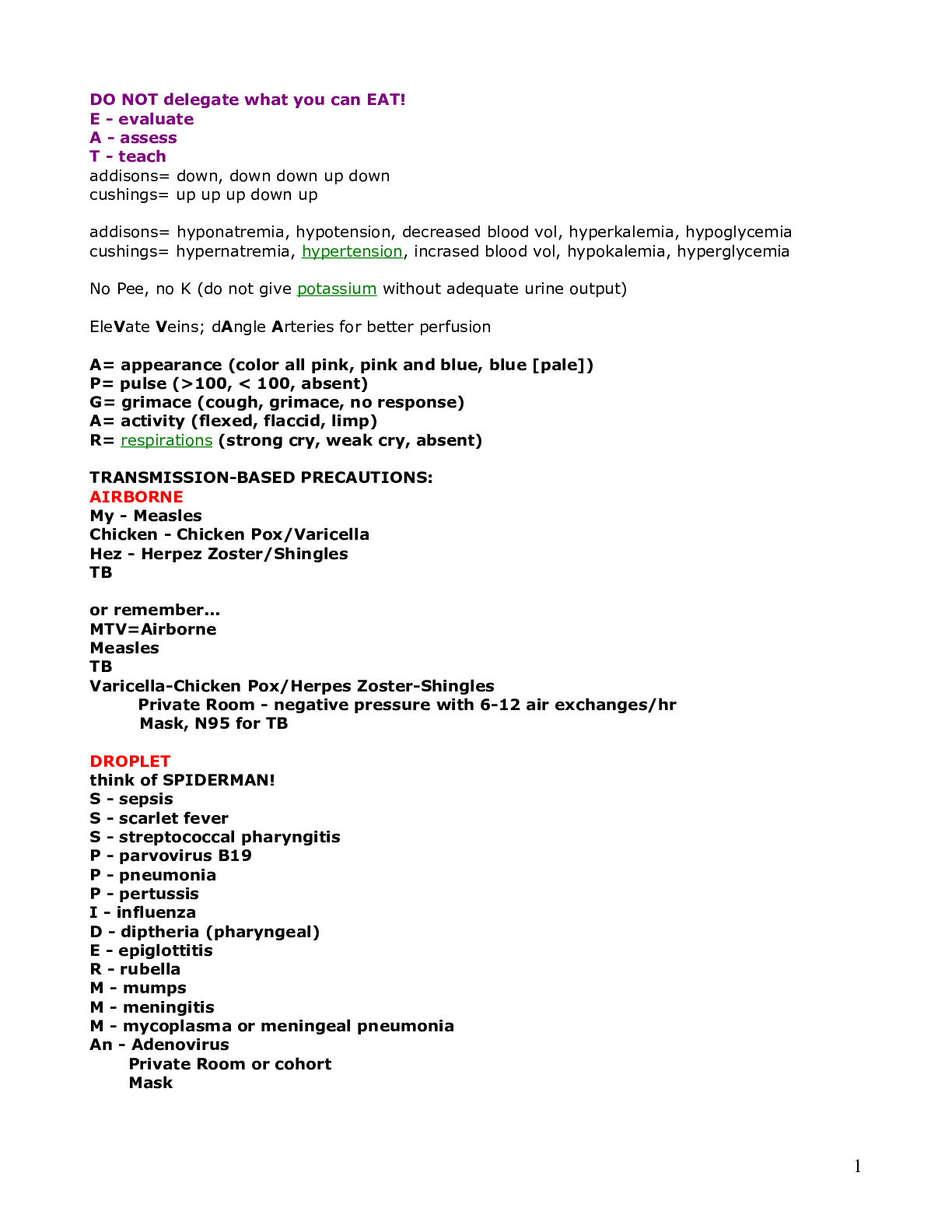
Reviews( 0 )
Document information
Connected school, study & course
About the document
Uploaded On
Nov 11, 2021
Number of pages
35
Written in
Additional information
This document has been written for:
Uploaded
Nov 11, 2021
Downloads
0
Views
152

